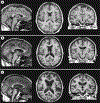Clinical and pathological features of alcohol-related brain damage
- PMID: 21487421
- PMCID: PMC8121189
- DOI: 10.1038/nrneurol.2011.42
Clinical and pathological features of alcohol-related brain damage
Abstract
One of the sequelae of chronic alcohol abuse is malnutrition. Importantly, a deficiency in thiamine (vitamin B(1)) can result in the acute, potentially reversible neurological disorder Wernicke encephalopathy (WE). When WE is recognized, thiamine treatment can elicit a rapid clinical recovery. If WE is left untreated, however, patients can develop Korsakoff syndrome (KS), a severe neurological disorder characterized by anterograde amnesia. Alcohol-related brain damage (ARBD) describes the effects of chronic alcohol consumption on human brain structure and function in the absence of more discrete and well-characterized neurological concomitants of alcoholism such as WE and KS. Through knowledge of both the well-described changes in brain structure and function that are evident in alcohol-related disorders such as WE and KS and the clinical outcomes associated with these changes, researchers have begun to gain a better understanding of ARBD. This Review examines ARBD from the perspective of WE and KS, exploring the clinical presentations, postmortem brain pathology, in vivo MRI findings and potential molecular mechanisms associated with these conditions. An awareness of the consequences of chronic alcohol consumption on human behavior and brain structure can enable clinicians to improve detection and treatment of ARBD.
Conflict of interest statement
Competing interests
The authors declare no competing interests.
Figures




References
-
- Lieber CS Alcoholic fatty liver: its pathogenesis and mechanism of progression to inflammation and fibrosis. Alcohol 34, 9–19 (2004). - PubMed
-
- Hillbom M, Juvela S & Karttunen V Mechanisms of alcohol-related strokes. Novartis Found. Symp 216, 193–204 (1998). - PubMed
-
- Victor M, Adams RD & Collins GH The Wernicke–Korsakoff Syndrome and Related Neurologic Disorders due to Alcoholism and Malnutrition, 2nd edn (Davis FA, Philadelphia, 1989).
-
- Zuccoli G et al. Neuroimaging findings in alcohol-related encephalopathies. AJR Am. J. Roentgenol 195, 1378–1384 (2010). - PubMed
Publication types
MeSH terms
Substances
Grants and funding
LinkOut - more resources
Full Text Sources
Medical
Molecular Biology Databases

